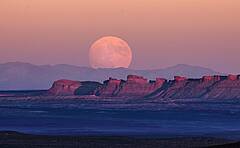The nights are getting shorter and shorter, the sun is rising higher and higher: it´s spring again! Hobby astronomers and professionals now have to wait much longer until the nocturnal celestial beauties can be clearly observed.
Because every day this month the sun rises around two minutes earlier and sets one and a half minutes later. At the beginning of April it rises at around 7 a.m. and sets at around 7:45 a.m. At the end of the month it will be light around six o'clock and only dark around eight eight. The length of the day increases over the course of the month from around 13 hours to 14 hours and 30 minutes at the end of the month.
In short: While it is really dark on April 1st from 9:30 p.m. to 5:00 a.m., on April 30th it is only dark between 10:30 p.m. and 4:00 a.m. There is a lot to see here - you can find an overview here, and much more details about the starry sky in April can be found in our Sky Guide.
Goodbye winter constellations, hello spring triangle!
Every night the winter constellations say goodbye more and more. When it is dark night around 10 p.m., Sirius can no longer be seen and Orion is so far in the west that the sky hunter can hardly be recognized. But the spring images have entered the heavenly stage with full force: Already towards the end of dusk, the lion, the virgin and the bear guardian are high in the south. At that time, right over our heads, at the zenith, is the Big Dipper. The striking constellation is easy to spot even for beginners. Extend the drawbar line of the Big Dipper three times and you will reach the star Arctur - one of the four brightest fixed stars in our starry sky. The orange-red glowing Arcture is also the main star in Bootes and forms the spring triangle together with the bluish-white glowing Spica in Virgo and Regulus in Leo. Far in the northwest, around midnight, the bright Vega, the main star in the constellation Lyra, can be seen. She announces the inevitable: the coming summer. Between Vega and Arctur you can see a semicircular constellation of stars: the northern crown. Its brightest star is the blue shimmering Coronae Borealis.
Finally falling stars again: the lyrids are coming
Exactly in the middle of the month we expect the falling stars of the Lyrids. They are active from April 16th to April 24th. The lyrids reach their climax on the night of April 22nd to 23rd. Around 20 meteors per hour then flare up in the night sky. By the way, the best time to observe is between midnight and two o'clock in the morning - however, the moon disturbs the experience a bit this year. The lyrids are the remains of the comet Thatcher C / 1861 G1, which orbit the sun. Every year in mid-April, Earth's orbit crosses the course of this meteor shower.
Mars in the evening, a planet duo in the morning - and a rare Mercury
The evening sky changes little compared to March: The only planet that is visible at dusk until after midnight remains Mars. He wanders from Taurus to Gemini in the course of the month and receives a visit from the waxing crescent moon on April 17th. A pretty sight not to be missed. Then, at the end of the month, Venus and Mercury appear on the evening west-northwest horizon around 8:45 p.m. Both planets are close to each other: on April 25th they are only two lunar widths away. While Venus only rises slowly higher, Mercury is traveling much faster and stands vertically above Venus on April 27th. However, Venus' visibility at the end of April is still quite weak - from May onwards it will accompany us as an evening star with increasingly better visibility. Mercury, on the other hand, is easy to spot with binoculars. In the morning sky, Jupiter and Saturn rule the scene. While it was still difficult to spot the gas planets at dusk in March, both are much cheaper in April. The smaller and less luminous Saturn rises first, followed by Jupiter - at the beginning of April just after half past five, at the end of April just before three.
Curtain up on the super moon
April 27th is full moon. And this month it not only appears larger than usual: At a distance of only 357,380 kilometers, the moon is also extremely close to the earth. Otherwise, on average, a good 30,000 kilometers more separate us from the earth's satellite. Since the moon affects the tides, spring tides can occur due to the greater proximity to the earth. The likelihood of earthquakes is also greater.
Category:
Bresser, Astro-News, Press, Start, Start

 Deutsch
Deutsch
 English
English
 Francais
Francais
 Español
Español
 Italiano
Italiano
 Nederlands
Nederlands
 Polski
Polski

